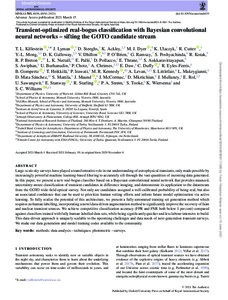Transient-optimized real-bogus classification with Bayesian convolutional neural networks - sifting the GOTO candidate stream
Killestein TL; Lyman J; Steeghs D; Ackley K; Dyer MJ; Ulaczyk K; Cutter R; Mong YL; Galloway DK; Dhillon V; O'Brien P; Ramsay G; Poshyachinda S; Kotak R; Breton RP; Nuttall LK; Palle E; Pollacco D; Thrane E; Aukkaravittayapun S; Awiphan S; Burhanudin U; Chote P; Chrimes A; Daw E; Duffy C; Eyles-Ferris R; Gompertz B; Heikkila T; Irawati P; Kennedy MR; Levan A; Littlefair S; Makrygianni L; Sanchez DM; Mattila S; Maund J; McCormac J; Mkrtichian D; Mullaney J; Rol E; Sawangwit U; Stanway E; Starling R; Strom PA; Tooke S; Wiersema K; Williams SC
Transient-optimized real-bogus classification with Bayesian convolutional neural networks - sifting the GOTO candidate stream
Killestein TL
Lyman J
Steeghs D
Ackley K
Dyer MJ
Ulaczyk K
Cutter R
Mong YL
Galloway DK
Dhillon V
O'Brien P
Ramsay G
Poshyachinda S
Kotak R
Breton RP
Nuttall LK
Palle E
Pollacco D
Thrane E
Aukkaravittayapun S
Awiphan S
Burhanudin U
Chote P
Chrimes A
Daw E
Duffy C
Eyles-Ferris R
Gompertz B
Heikkila T
Irawati P
Kennedy MR
Levan A
Littlefair S
Makrygianni L
Sanchez DM
Mattila S
Maund J
McCormac J
Mkrtichian D
Mullaney J
Rol E
Sawangwit U
Stanway E
Starling R
Strom PA
Tooke S
Wiersema K
Williams SC
OXFORD UNIV PRESS
Julkaisun pysyvä osoite on:
https://urn.fi/URN:NBN:fi-fe2021093047899
https://urn.fi/URN:NBN:fi-fe2021093047899
Tiivistelmä
Large-scale sky surveys have played a transformative role in our understanding of astrophysical transients, only made possible by increasingly powerful machine learning-based filtering to accurately sift through the vast quantities of incoming data generated. In this paper, we present a new real-bogus classifier based on a Bayesian convolutional neural network that provides nuanced, uncertainty-aware classification of transient candidates in difference imaging, and demonstrate its application to the datastream from the GOTO wide-field optical survey. Not only are candidates assigned a well-calibrated probability of being real, but also an associated confidence that can be used to prioritize human vetting efforts and inform future model optimization via active learning. To fully realize the potential of this architecture, we present a fully automated training set generation method which requires no human labelling, incorporating a novel data-driven augmentation method to significantly improve the recovery of faint and nuclear transient sources. We achieve competitive classification accuracy (FPR and FNR both below 1 percent) compared against classifiers trained with fully human-labelled data sets, while being significantly quicker and less labour-intensive to build. This data-driven approach is uniquely scalable to the upcoming challenges and data needs of next-generation transient surveys. We make our data generation and model training codes available to the community.
Kokoelmat
- Rinnakkaistallenteet [27094]
